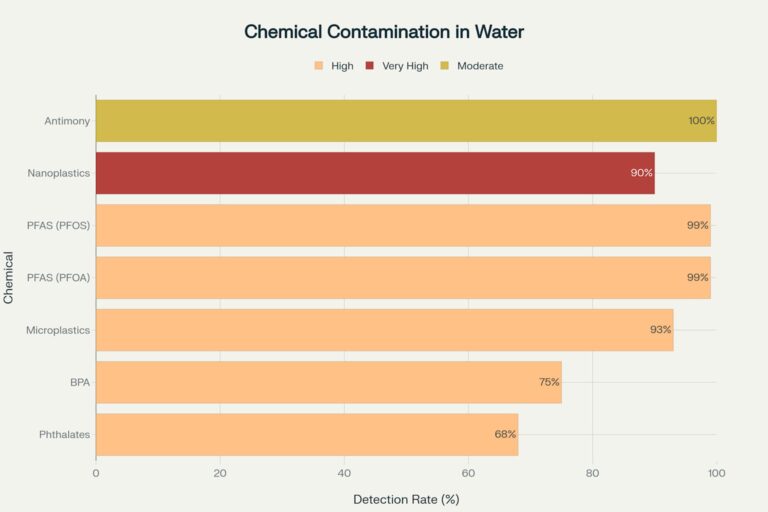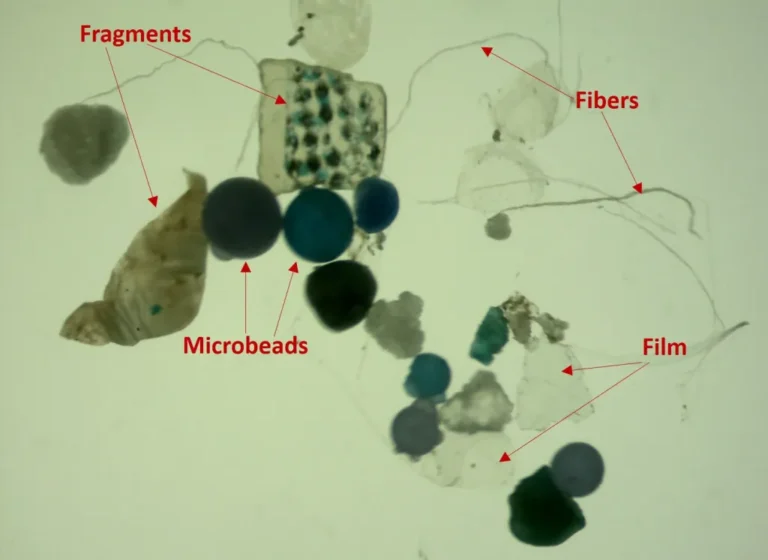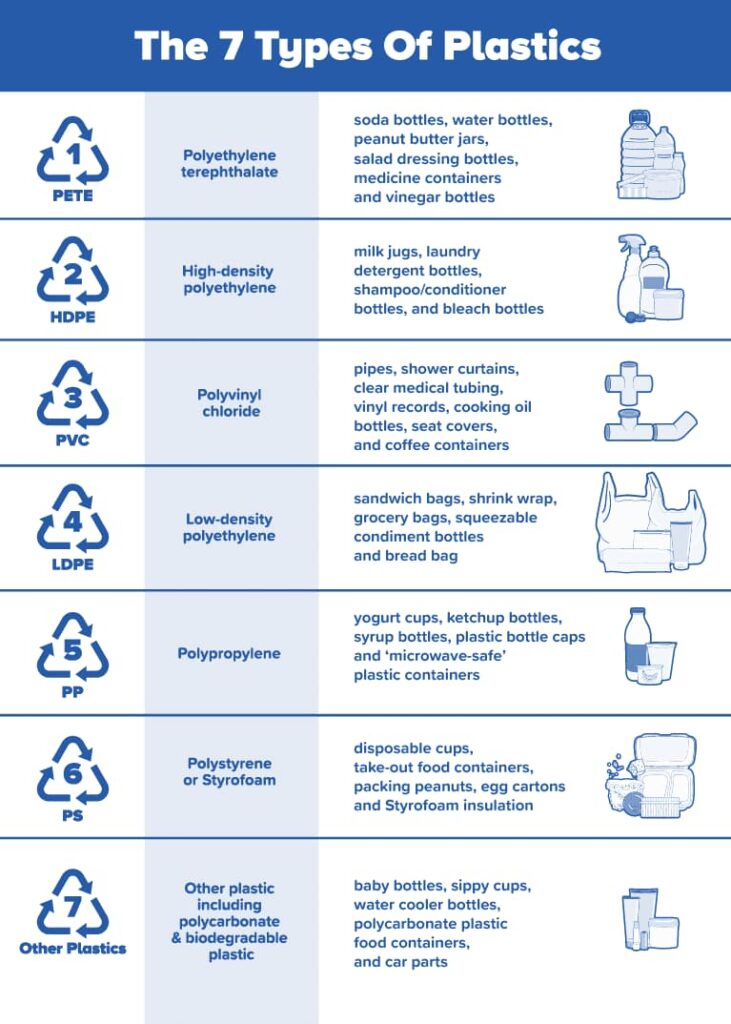Every day, millions of people grab a plastic water bottle. Most people don’t think about what might be getting into their drink. We worry about clean water, but we forget about the bottle that holds it. New research shows a scary truth: the bottles we use to stay healthy might be making us sick with harmful chemicals.
This guide will help you understand what chemicals to avoid. You’ll learn how to find safer water bottles. Making the switch to safe bottles is one of the best health choices you can make.
When ready, check out this post on safe water bottles to use for reduced chemical exposure.
How Many Plastic Bottles Do We Use?
The numbers are shocking. Americans use 86 billion plastic water bottles every year. That’s
almost 3 million bottles every hour! Only 28% of these bottles get recycled. The rest end up in
trash dumps, oceans, or get burned. When they burn, they release toxic chemicals into our air.
This huge amount of bottles isn’t just bad for the environment. It’s also bad for our health. Each
bottle can contain dozens of harmful chemicals. These chemicals can get into the water you
drink.
The Chemical Problem in Bottled Water
New research shows that bottled water is not as clean as companies say it is. Studies show that
bottled water contains many harmful chemicals

Nearly all bottled water contains harmful chemicals, with PFAS “forever chemicals” detected in 99-100% of samples and microplastics found in 93% of bottled water tested
Tiny Plastic Pieces: The Hidden Danger
The most scary discovery is tiny plastic pieces in bottled water. These are called microplastics
and nanoplastics. A big study in 2024 by Columbia University found something amazing. A
typical bottle of water contains 240,000 tiny plastic pieces. That’s 10 to 100 times more than we
thought before.
These tiny pieces are so small they can get into your blood. They can reach your organs and
even your brain. The smallest pieces are the most dangerous. They’re so tiny that your body
thinks they’re natural parts of your cells.
PFAS The “Forever Chemicals”
Even more scary is something called PFAS. These are nicknamed “forever chemicals” because
they never break down. They stay in the environment and in your body forever. Studies show
that two of the most toxic PFAS chemicals are found in over 99% of bottled water worldwide.
These chemicals have been linked to cancer, liver damage, and weak immune systems. They
can also cause problems in growing children. Health experts say there’s no safe amount of these
chemicals.
Other Toxic Chemicals
The contamination doesn’t stop there. Research has found many other harmful substances in
bottled water:
BPA: Found in 75% of plastic bottles. This chemical messes with your hormones. It can
cause problems with having babies, early puberty, and more cancer risk.
Antimony: A cancer-causing metal used to make plastic. Found in 100% of plastic bottles
tested.
Phthalates: Chemical softeners found in 68% of bottles. Linked to hormone problems and
trouble having babies.

Various forms of microplastics, including fragments, microbeads, fibers, and film, as seen under a microscope (agatemag)
The Health Risks: What Science Shows Us
The health problems from these chemicals are becoming clearer as research continues. A big
study in 2024 found that tiny plastic exposure is “suspected” to hurt human health. It affects
reproduction, digestion, and breathing.
Heart Disease and Chronic Illness
New research in 2025 found something important. Tiny plastic exposure is in the top 10 things
that predict chronic disease. It’s as bad as not having health insurance when it comes to
predicting stroke risk.
Hormone Problems
Chemical contamination from plastic bottles can mess with your body’s natural hormones. This can lead to:
-Problems having babies: Poor sperm quality, fertility problems, and early puberty
-Weight and diabetes problems: Higher risk of obesity and diabetes
-Growing problems: Especially bad for pregnant women and children
-Long-term Health Effects
-Studies have linked plastic chemical exposure to higher rates of:
-Heart disease
-Cancer (especially reproductive cancers)
-Weak immune system
-Brain and nerve problems
-Liver and kidney damage
Temperature Makes It Worse
Research shows that chemical leaking gets much worse with heat. At 113°F, chemical movement
from plastic bottles increases a lot. At 122°F, antimony levels can become unsafe within 24
hours. This means plastic bottles left in hot cars, stored in warm places, or left in sunlight are
much more dangerous.
The Safe Choices: Materials That Protect Your Health
The good news is that several materials offer safe, non-toxic alternatives to plastic bottles.
Stainless Steel: The Best Choice
Food-grade stainless steel 18/8 or 304 grade) is the safest choice for water bottles. Research shows that properly made stainless steel bottles:
– Have no BPA, PFAS, phthalates, or other harmful chemicals
– Don’t leak any substances into water
– Keep water taste and purity
– Last a very long time (scoring 9/10 in material comparisons)
When choosing stainless steel, make sure it’s unlined and doesn’t have plastic parts that could add chemicals.
Glass: Pure and Chemical-Free
Glass bottles offer the purest water taste and complete freedom from chemical leaking. They’re
100% recyclable and don’t keep flavors or smells. However, they’re heavier and break easier
than other options. Many now come with protective rubber sleeves.
Similiar to stainless steel, look out for potential plastic parts or colored elements that may contain chemicals which could leak in to the liquid.
What to Avoid
Aluminum bottles often need interior coatings that may contain BPA or other chemicals. While
the aluminum itself isn’t toxic, the coatings can be problematic.
“BPAFree” plastic bottles may still contain other harmful chemicals like BPS or phthalates.
Studies show that even BPA-free plastics can leak hormone-disrupting chemicals.

An infographic detailing the 7 types of plastics, their recycling codes, and common uses, including water bottles (cohenusa)
Making the Switch: Steps You Can Take Right Now
Stop Using Single-Use Plastic Bottles
The most important step is to stop using single-use plastic bottles. They contain the highest
levels of harmful chemicals and hurt the environment the most. This change alone greatly
reduces your chemical exposure.
Upgrade Your Reusable Bottles
If you’re currently using plastic reusable bottles, think about upgrading to stainless steel or glass
alternatives. The initial cost pays off in both health protection and long-term durability.
Storage and Care Tips
– Never leave any bottle in hot cars or direct sunlight
– Clean bottles regularly with warm, soapy water
– Replace bottle parts (like rubber seals) if they show wear
– Avoid washing plastic bottles at high temperatures
– The Connection to Better Choices
Understanding these health risks makes the choice clear. Investing in a high-quality, non-toxic
water bottle isn’t just about helping the environment. It’s about protecting your health and your
family’s health.
Products like the Bambaw Stainless Steel Water Bottle show what to look for in a safe
alternative. Made from food-grade stainless steel with a natural bamboo lid, it eliminates plastic
contact with your water. It offers the durability and performance you need for daily hydration
Conclusion: Your Health Is Worth the Investment
The evidence is clear: plastic water bottles pose significant and unnecessary health risks through chemical contamination. From tiny plastics that can get into your bloodstream to forever chemicals that build up in your organs, the hidden dangers in plastic bottles far outweigh any convenience they offer.
Making the switch to safe materials like stainless steel or glass isn’t just a lifestyle choice. It’s a health necessity. While the initial cost may be higher than disposable bottles, the long-term benefits to your health, your wallet, and the environment make it one of the smartest investments you can make.
Every bottle of water you drink from a safe, non-toxic container is a step toward better health and a cleaner environment. The choice is yours, but now you have the knowledge to choose wisely.
Ready to make the switch? Check out our detailed reviews of the safest water bottles available. We include specific product recommendations that meet all safety criteria while offering the durability and performance you need for healthy hydration.
